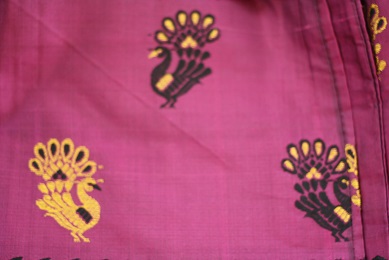THE MEKHALA CHADOR POST BY OUR GUEST BLOGGER KUMKUM NUNGROM
The state of Assam is one of the striking regions of India. There is hardly any other state which has greater variety and colour in its natural scenario and in the cultural treasures of the people that inhabit it. The region combines the ethnic setting of weaving skills in white and golden Assam silk, indigenously called Pat and Muga, together with agriculture and fishing in the neighbouring villages.
Mekhela chador is the traditional Assamese dress worn by women. It is undoubtedly one of the most elegant costumes worn in any of the Indian states. There are two main pieces of cloth that are draped around the body. The bottom portion, draped from the waist downwards is called the mekhela. It is in the form of a very wide cylinder that is folded into pleats to fit around the waist and tucked into an underskirt.

The Mekhala Chador is the Assamese style of draping a 2-piece garment with a blouse
The top portion, known as the chador, is a long length of cloth that has one end tucked into the upper portion of the mekhela and the rest draped over and around the rest of the body. Invariably there is a blouse that is worn underneath, which is similar to a saree blouse.
Assam is the home of several types of silks, the most prominent and prestigious being the muga, the golden silk found exclusively in this state. It is said that the muga silk is a family heirloom and is often passed on through generations due to its strength, durability and sheer beauty. It is known to outlive a few generations….at least!!
The weaving tradition of Assam can be traced to the 11th century when king Dharma Pal, of the Pal Dynasty, sponsored the craft and brought 26 weaving families from Tantikuchi to Sualkuchi. The village took shape as a weaving village after the Mughals were defeated in the 17 th century. Since then, most Assamese homes in the traditional weaving villages, both in the lower and upper banks of the Brahmaputra, boast of a loom, and weaving is part of life. So much so, that the great Mahatma Gandhi once remarked that ‘the Assamese women weave dreams in their looms’!
Assam silk denotes the three major types of indigenous silks produced in Assam; the golden Muga, the white Pat and the warm Eri silk. The Assam silk industry, now centered in Sualkuchi, is a labor intensive industry.
Muga silk is the product of the silkworm “Antherea assamensis” and endemic to Assam. The pupa of these silkworms feed on “som” (“Machilus bombycina”) and “sualu” (“Litsaea polyantha”) leaves. The silk produced is known for its glossy fine texture and durability. Due to its low porosity, the Muga yarn cannot be bleached nor dyed and its natural golden color is retained. This silk can be hand-washed with its luster increasing after every wash. Assam has received a geographical indication for the production of Muga.
Pat silk is produced by silkworms which feed on mulberry leaves. It is usually brilliant white or off-white in colour. This silk cloth has the ability to dry in shade. Eri silk is made by “Philosamia ricini” which feed on castor leaves. It is also known as Endi or Erandi silk. Due to the fact that manufacturing process of Eri allows the pupae to develop into adults and only the open ended cocoons are used for turning into silk, also popularly known as non-violent silk. This silk is soft and warm and is popular as shawls and quilts.
There are some popular weaving motifs on the ‘mekhela chadors’. The most commonly used are the khing-khap, (emblem), mogor (creeper ), mina (jewel), miri (tribal art) , gos (tree), jaapi ( bamboo hat), moyur (peacock), gor (rhino) and the gumkharu (traditional bracelet) designs. All in all, most of them are the aristic translation of everyday objects on the cloth or silk.
The traditional silk mekhela chador has become very popular amongst the ‘saree – enthusiasts’ in the larger cities of the country. It is every such woman’s dream to own either a muga or a paat set for its sheer grace, elegance and exclusivity!
THE MEKHELA CHADOR GALLERY

A close up of the miri or tribal design. Brilliant colours.

A phool design on a resplendent pat silk

A moyur design on a pat silk
All the images in this post are the courtesy and copyright of the author of this post – Kumkum Nongrum.
Sources:
http://www.assaminfo.com/tourist-places/32/sualkuchi.htm
https://en.wikipedia.org/wiki/Mekhela_chador

























its such a pleasure, Punam… so musch info n so interestingly narrated… love it !!
Thanks Anu for you continued interest in my blogs 🙂
Wow. I’m just overwhelmed with the mixture of research , initiative , information , perseverance and finally serendipity that this blogpost holds. I’m on a quest for sarees , honestly to just wear them , and enroute , to understand the different weaves. Its mindboggling. One begins to understand certain patterns and styles and then suddenly some weaver is in a mood for some fun and you’re holding a saree , which one cant identify. There go few nights , which could have been enjoyed in slumberland, instead you’re awake , cursing and googling ( Google is rubbish when saree researching) . Im glad to have found you and you’re blog and I’m hanging around here now. I’ve acquired 2 Mekhela Chadors and love wearing them , even in far away , humid, muggy Mumbai.
Thank you Rupali. Carry on wearing sarees 🙂